From the Assistant Director of Early Learning
Dear Families
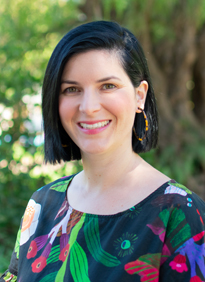
Last week I walked into one of the classrooms and a teacher was carefully rearranging and organising the children’s portfolios. She was ensuring that they were all standing upright, the covers facing outwards and they were perfectly positioned on the shelf. A child then approached, found their portfolio and sat down and began looking through the folder with great care. Our ELC educators take great pride in the presentation of your child’s portfolio, but more importantly, emphasis is placed on the content.
Each child has their own portfolio which is a collection of learning. It highlights their involvement in the group investigations that are occurring within the classroom and beyond. The portfolio contains samples of your child’s work, photographs, quotes, questions and or creations that represents your child’s thinking and understandings of the learning intention. The portfolio is much more than a folder for storing work samples, it gives visibility to your child’s learning journey during their time at the ELC.
Your child’s portfolio contains an end of term summary where the teachers communicate with you regarding your child’s participation in and contribution to the projects within their learning community. This is one form of reporting and assessment that reflects your child’s progress and development of learning. The work samples, photographs, quotes and transcripts placed in the portfolio are examples of their participation. Over time, the portfolio shows your child’s growth and development.
The educators use the children’s portfolios as a teaching tool, where they encourage the children to reflect and revisit the work samples in their portfolio to initiate further investigation or build upon ideas from previous group experiences.
The children’s portfolios are available within the classrooms, and you can view them any time you visit the Centre. The portfolios are supported by the ongoing documentation that is displayed on the walls, available for viewing through our digital homepages and newsletter. We continue to invite you to provide feedback to your child about what you view in their portfolio using our pro formas, or simply on note paper. Please give them feedback or ask them questions, because this empowers their future participation and can often be the springboard we need to deepen our investigations. If you would like to take your child’s portfolio home, please see your child’s teacher to organise this. We only ask that you return them in a timely fashion so that they can continue to be updated.
I hope this week, you might be able to set aside some time to look through your child’s portfolio.
Kind regards
Kirsty Porplycia
Assistant Director of Early Learning
Save the Date
Friday 22 November: ELC Christmas Celebration, 5pm
Monday 2 December: ELC Hat Ceremony, 12.15pm
Thursday 5 December: ELC Farewell Afternoon Tea for Learning Community 2, 2.30pm
Friday 6 December: Last day of Term 4
Monday 9 December: Vacation Care begins
December 23 – January 3: ELC Closed
ELC Christmas Celebration
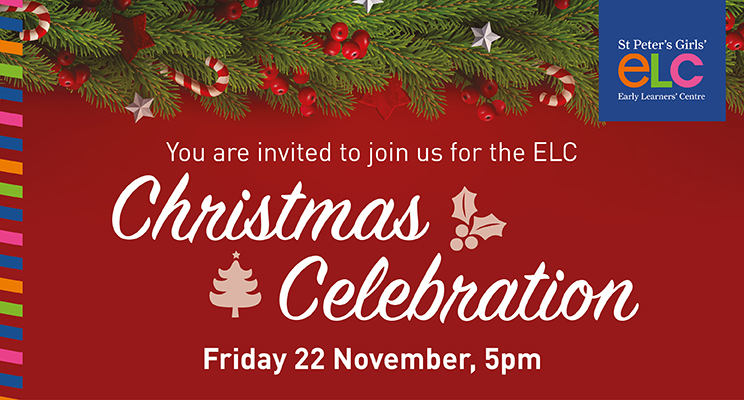
Join us on Chiverton Lawns for our ELC Christmas Celebration on Friday 22 November at 5pm.
Invites will be distributed this week. We ask that children arrive at the ELC at 5pm, as they will begin presently promptly at 5.15pm.
Families can bring their own picnic basket, rug and nibbles. Drinks will be available to purchase at the bar. Mercato and Chesini House are generously donating pizza slices.
We look forward to celebrating a wonderful year with our beautiful community.
Portfolios in the ELC
Across the ELC, the children’s portfolios are a valuable documentation tool which showcases their learning journey. Watch our video to see more, as we invite families to share in this special sharing ritual with the children.
Learning Community 2 Farewell Picnic
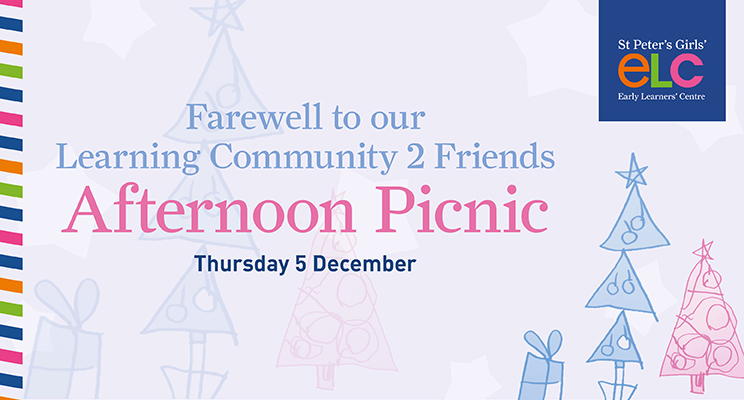
Families of Learning Community 2 children are invited to the ELC for a picnic to farewell our friends and celebrate a fun and successful 2019.
Thursday 5 December
2.30 – 3.30pm
ELC Hallett Garden
Afternoon tea will be provided.
Vacation Care Bookings
Vacation Care begins on Monday 9 December. Booking forms will be available this week, if you haven’t received one you can download a copy here.
Please note that the ELC will be closed from Monday 23 December and will reopen on Monday 6 January. Term 1 begins on Wednesday 29 January 2020.
Sun Safety in the ELC
Please can your child bring to ELC, each day that they attend, a broad brimmed hat. If you do not have an ELC uniform hat, we ask that you pack another broad brimmed hat for your child to wear at ELC. As we move into the warmer months, it is extremely important that we adhere to our policies and procedures. If your child does not have a hat, they will be asked to play under the shaded areas or indoors.
Please note that sun cream application is also being undertaken regularly at the ELC; if your child requires an alternative sun cream, please provide this to your child’s teacher. We also ask that your child wears their correct ELC uniform, and refrains from wearing dresses or singlets where the shoulders are exposed. Appropriate footwear is also required and we ask that children wear sneakers or sandals that have a backing to them.
Children’s Lunch Boxes
With the weather warming up, it is important that your child’s lunches are prepared and stored safely to avoid the risk of food poisoning. Keep pre-made lunch boxes in the fridge until they are ready to be packed into your child’s bag. We ask that you pack a frozen ice block/ice pack in your child’s lunch box to keep food cold. Please consider healthy, safe lunch box alternatives such as fruits and vegetables, and please ensure your child has a drink bottle filled with water each day they attend ELC. The staff can refill the bottles if required throughout the day.
ELC Immunisation Policy
Under the Government’s No Jab No Pay policy, families must meet immunisation requirements to receive the Child Care Subsidy. Further information is available from the Department of Health by clicking here.
Children with high risk conditions, as well as children who are not immunised against them, may be excluded from the ELC in accordance with the ‘Staying Healthy: Preventing infectious diseases in early childhood education and care services’ guidelines. Please refer to our Exclusion Policy for further information.
Common illnesses requiring exclusion include:
Influenza
Chicken Pox
Conjunctivitis
Diarrhoea
Hand, Foot and Mouth Disease
High Temperature
Infectious Hepatitis
Measles
Meningitis
Mumps
Rubella (German Measles)
Scabies
Scarlet Fever
School Sores (Impetigo)
Upper Respiratory Tract Infection
Vomiting
Whooping Cough
Absences in the ELC
Student Absences
Please notify the School via one of the following methods for late arrivals/early departures and absences, ensuring a reason for the absence is included.
Text: 0428 601 957 (save to phone contacts as SPGS)
Email: attendance@stpetersgirls.sa.edu.au
Phone: 8334 2200 or phone the relevant room as per the contact list
Feel free to also include the relevant room teacher when sending via email.
ELC Room Contacts:
Bell Yett – 8155 5777
Ferguson – 8155 5776
Hallett – 8155 5775
Stonyfell – 8155 5778
来自黄老师的信息

亲爱的家长朋友们:
在ELC,每一个小朋友都有他们自己的学习文件夹,文件夹里包含了他们在ELC的学习日常。这也展示了他们在课堂内外以及在小组探讨里的学习情况。在文件夹中还会包含一份学期末的总结,这份报告总结了老师和家长交流小朋友在小组学习中参与和贡献。这也是对小朋友的进步和发展的一份总结和评价。在文件夹里的每一份学习样本、照片、文字记录都展示了他们的学习成果。这些记录也展示了小朋友们每一个成长的轨迹。在这一周,我们期待家长朋友们能坐下来陪伴小朋友们一起翻阅他们的学习文件夹,一起来回顾他们的成长瞬间。更期待家长朋友们的反馈。
Emma works in Learning Community 2 on Mondays, Thursdays and Fridays from 9am – 5pm.
Learning Community 1
News from the Stonyfell Room
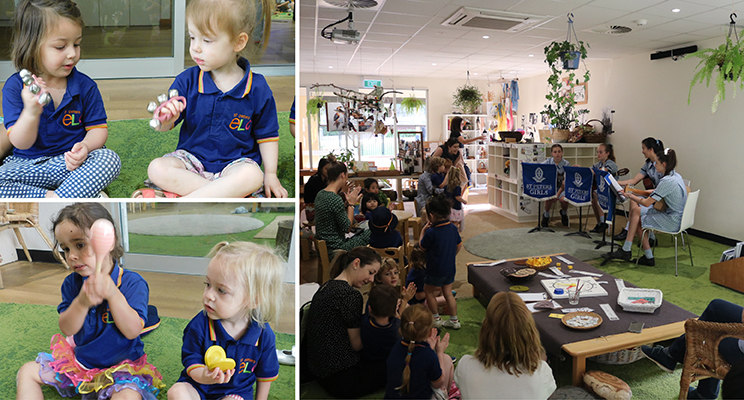
Do you listen to music with your children? Did you know that music-making in the home from around the ages of two and three can lead to better literacy, numeracy, social skills, and attention and emotion regulation by the age of five?
Music and song are central components of early childhood education. In Learning Community 1 we recognise that opportunities for singing, dancing, listening to and playing music has many benefits. From a cultural perspective, music is a language that speaks to everyone, no matter what their background. We often find that familiar nursery rhymes have the power to instantly calm new students who are finding their new environment overwhelming, especially those from a non-English speaking background. We have also learned a number of songs in Mandarin that we all enjoy. In Kaurna culture, music and song is the way that language and values are taught. These are just a few examples of how music is a universal language that has the power to connect and communicate beyond the spoken word.
In Learning Community 1 we have many opportunities throughout the day and the week. We know songs that are made up of English and Kaurna, including:
Niina marni hello, hello, hello, how are you? Niina marni hello, hello, hello, how are you?
We are on Kaurna land, Kaurna land, Kaurna land
We are on Kaurna land, Kaurna land, Kaurna land here today
“I can see that the clear intention at the ELC for these children’s learning is the way the educators are teaching my language through song and that is how Kaurna youth are taught language… through song.” – Tamaru
Exposure to different styles of music and musicians develops children’s ear for the instruments and sounds. We have been very thrilled to host different ensembles from the school in recent weeks, including flutes and guitars. This gives the children further exposure to the possibilities of creating different sound, rhythm and melodies. It builds an understanding of the language of music, and a chance to simply enjoy music.
From the gift of a special rock given to us by Hudson Duldig’s Nanny Heather, we have composed a song called ‘The Ritual of the Rock’ that tells the story of this rock in both English and Kaurna. Each day Stonyfell and Bell Yett children and educators combine to create lyrics and music, using tamborines, bells and maracas. We are looking forward to guest musician Ned Baulderstone working with us in Week 4 to further develop this project.
We also appreciate the opportunities that we are having to connect with our school and the broader community through our shared love of music. If you would like to participate please talk to us about how and when, everyone is welcome!
Mel Angel
News from the Bell Yett Room
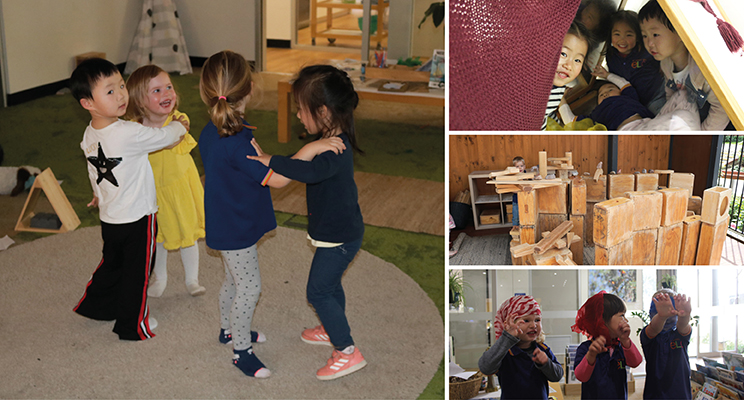
Designing for Play
Recently, over a dinner conversation on a Friday night, I was challenged with “why do you spend so much time on the weekend planning for work, don’t your kids just play all day?”…
In early education, something that can be overlooked, or taken for granted, is the intention that goes into designing for play. How play is incorporated into an early childhood curriculum will vary across each context and setting, however early childhood educators share an inherent understanding of the significance that play holds for young children to learn, form relationships and make sense of their world.
When considering our learning experiences at ELC, educators experience a constant cycle of self-questioning. We will ask ourselves, what do we want to learn? What are we curious about at the moment? How can we create a learning experience that is not too simple that our children will lose interest and move on quickly, and not too difficult that they will struggle to persist? How do we do this for an extensive range of age and ability in the room? We do it through careful design, underpinned always by an element of playfulness.
Easily identifiable opportunities for play will invite participation. What tools and materials should be offered? Children desire to mimic those important to them in the adult world. Being trusted with ‘real’ tools and materials is empowering. We do not offer the ‘child version’, we communicate trust through the accessibility of ceramic teacups, hammers, heavy pieces of wood. Materials and tools are considered for the opportunities they provide for constant experimentation and individual interpretation. We follow instructions our whole day, play must be open-ended and full of unique possibilities.
We consider inclusivity. Are our experiences accessible by everyone? Are we providing just enough so that the children can ‘take it from here’? What is the physical space offering? What will they make of it? The considerations for an early childhood educator when designing for play are endless. We recognise play as therapy, something that engages our brain, senses and emotions. Our minds and bodies must coordinate to be able to participate. With play there is no outcome, other than it is intuitive.
Annabelle Redmond
Learning Community 2
News from the Ferguson Room
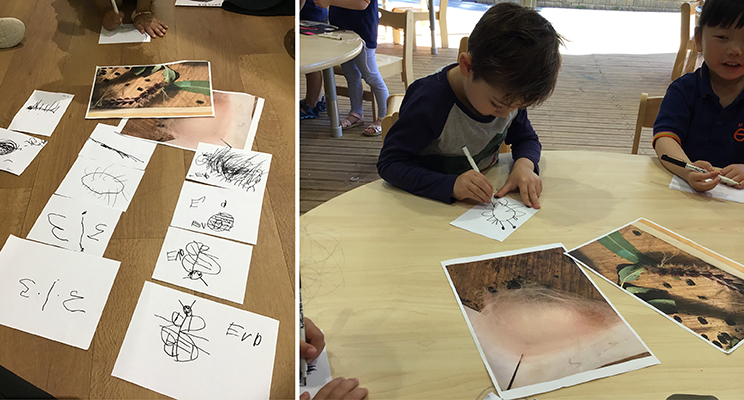
Hairy Mary, A Provocation for Inquiry
As most of you would know, Hairy Mary has become an important member of our learning community and this living creature has become deeply embedded in our ongoing inquiry investigations, continuing to provide the children with curiosity and wonder. At the end of Term 3 we were privileged to watch Mary (as she is fondly named) weave her cocoon. We have been unable to find out how long she will remain in her cocoon so the children have continued to hypothesise how long she will be in the cocoon and how she will look when she emerges. This thinking has fueled our ongoing investigations and we have begun documenting the stages that Mary has been through, focusing on using the intentional language of past, present and future:
“In the past Mary was a hairy caterpillar.”
“In the present she is a pupa inside a cocoon.”
“In the future she will be a moth, maybe a hairy moth!”
The children have each created a representation of what they believe the Hairy Mary moth will look like. They have drawn on our past research to include various details they have learnt about. One of the children added a very specific detail on their work, an arrow, the child shared that the inclusion of the arrow tells you how to follow the changes Mary goes through. This provocation was brought to the group and we began to explore the arrow symbol and the life cycle of a moth. We explored books and various websites to find out the information we needed. We role played the stages in the cycle and then we challenged the children. Could we draw the life cycle? They all worked hard on their representation, each child experimented with the arrow symbol and the various stages of transformation.
Our ongoing investigation has allowed us to develop a range of skills. Some of these have included:
- The ability to be a researcher and know how and where to find out more
- The ability to hypothesis and test a theory
- Deepening literacy and language skills
For more information and examples of your child’s involvement in this ongoing inquiry work we invite you to look in their individual portfolios.
Laura Reiters
News from the Hallett Room
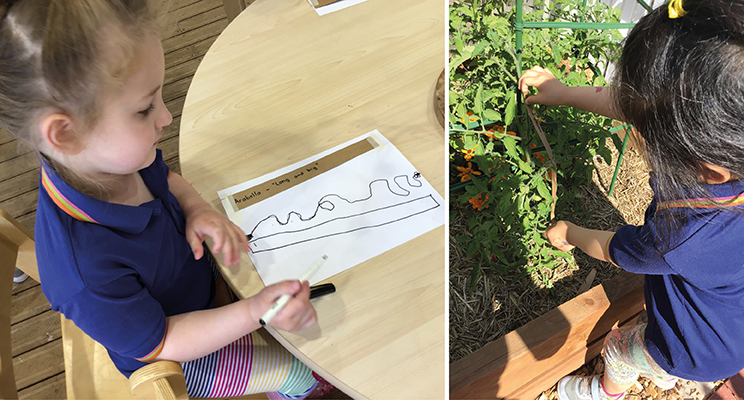
A Garden of Possibilities… Mathematical Possibilities
Building on the children’s curiosity and desire to learn more about the plants we are growing in the ELC Community Garden, the educators are providing learning experiences that support the development of mathematical thinking, skills and concepts. As the children investigate and research the plants, we are inviting them to identify and describe the attributes of each plant.
“Attributes are qualities or characteristics that are used to ascribe particular aspects of features. Attributes are important for the concept of pattern and early algebra to define objects by shape, size or colour.” – Marianne Knaus, Maths Is All Around You
Last week we invited the children to be an Attribute Detective as we played a game of Who Am I. The children were highly motivated to use a range of clues/attributes to guess the plant.
- I am green
- I have leaves
- I do not grow tall, I grow long on the ground
- My leaves are shaped like a love heart
Using photographs of our plants as an observational tool, the children were able to eliminate the plants without the stated attributes. Can you guess the plant? Can you play a similar game at home with your child?
We then invited the children to select a piece of cardboard and name its attributes using the vocabulary of measurement, for example, big, small, tall, short, long, thin, wide and narrow. The children then had to be detectives and find something in the ELC Community Garden with the same attribute as their piece of cardboard. The children had so much fun, comparing, matching and exploring with their friends, all while co-constructing their mathematical knowledge, skills and dispositions.
This learning experience also gave the educators some valuable insights into the children’s mathematical understandings. We know we have more work to do to support the development of the children’s mathematical language and the understandings of concepts such as; long refers to length and tall refers to height. How wonderful we have a garden of possibilities in our backyard!
Nell Tierney and Leanne Williams
